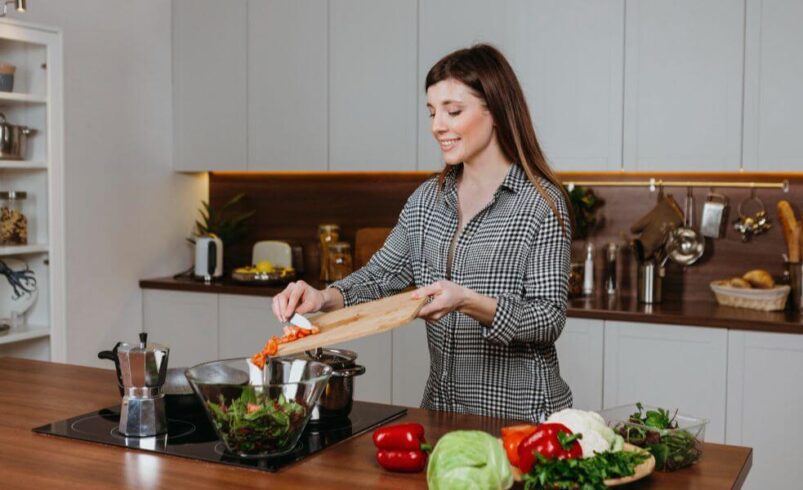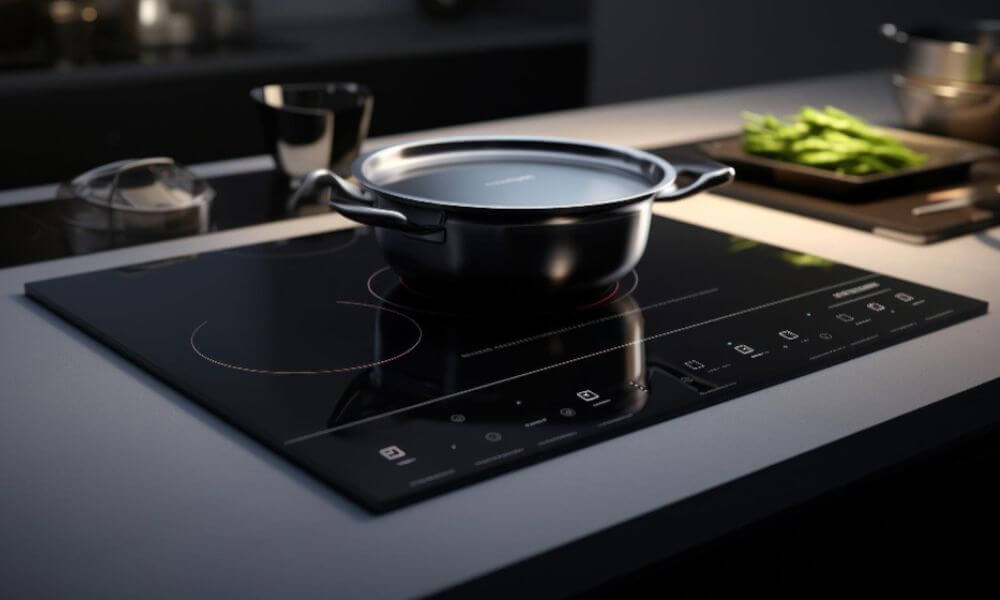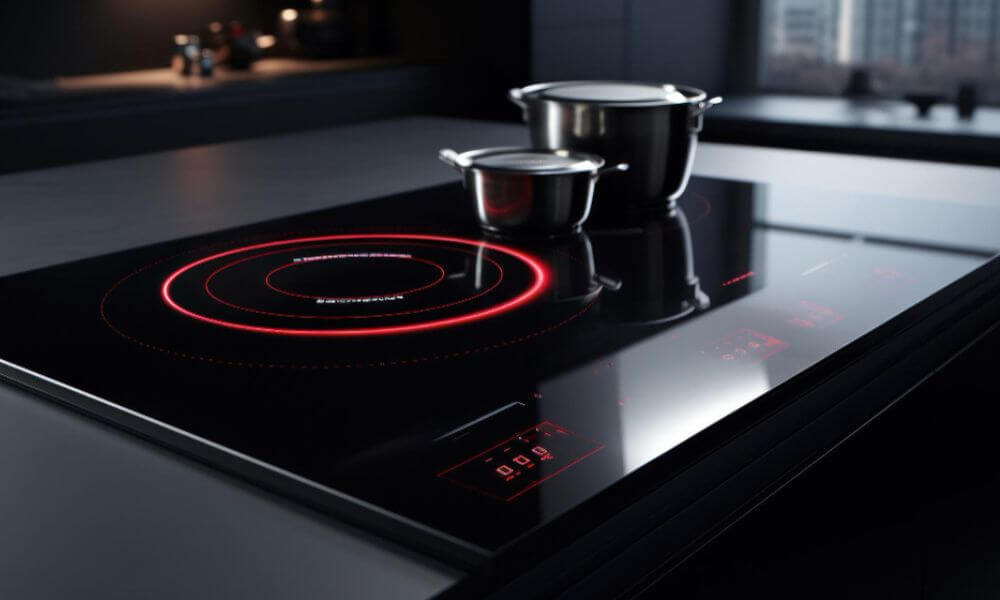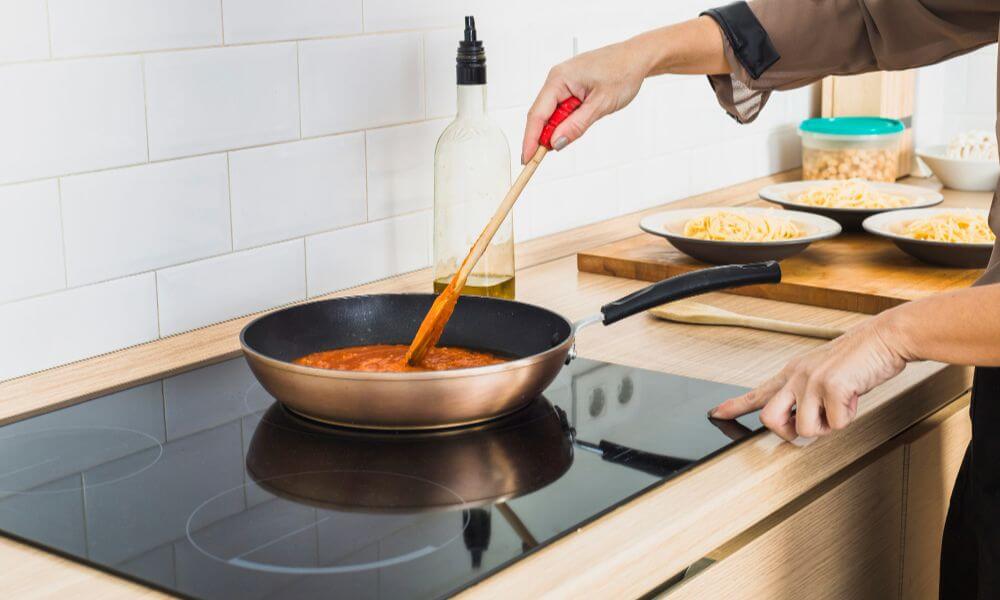Induction VS Radiant Cooktop – What Is The Best Cooktop


Are you curious about the differences between induction vs radiant cooktop? With new cooking technologies constantly emerging, it can be challenging to distinguish between the two amidst all the marketing hype. As someone who has used both cooktops, I have firsthand experience with their performance and pros and cons.
This informative post aims to provide an accessible overview of radiant and induction technology. By exploring factors such as heating precision, efficiency, ease of use, and cleaning, readers can gain valuable insights to determine which style suits their cooking needs and lifestyle. Let’s dive in!
How does induction cooking work?

Induction cooktops create a magnetic field that interacts with the iron content in your cookware. The magnetic field generates small electrical currents in the pan, quickly and directly heating it. This leads to faster cooking times, heating, and precise temperature control. Induction cooktops offer a sleek design with no exposed heating elements or flames.
How does Radiant cooking work?


Radiant cooktops use electric heating elements underneath a smooth ceramic or glass surface. When turned on, the elements heat up, and the heat radiates through the cookware to cook food. Radiant cooking offers a traditional cooking experience with a visible flame or red-hot coil and allows for various types of cookware to be used.
Induction vs Radiant Cooktop – Detailed Comparison
Stay tuned as we explore radiant and induction technology further to help you make an informed decision for your kitchen. Radiant cooktops are also more affordable upfront, making them a popular choice for budget-conscious consumers.
However, one drawback of radiant cooktops is that they can take longer to heat up and cool down compared to induction cooktops, which can be a concern for those who want fast results in the kitchen. Additionally, since radiant cooktops rely on conduction for heating, they are less precise and efficient than their induction counterparts.


Heating Efficiency: Which one heats food faster – Induction vs Radiant Cooktop
Regarding heating efficiency, which cooktop is faster at heating food – induction or radiant? Well, induction cooktops have a clear advantage. Thanks to their direct and intense heat transfer method using magnetic currents, induction cooktops can boil water and cook food significantly faster than radiant tops. Studies have shown that induction cooktops can be up to 50% more efficient in energy usage than traditional radiant tops.
Temperature Control: Which cooktop gives you more precise temperature control?
What about spill resistance? Both induction and radiant cooktops have their unique advantages. An induction cooktop makes spills less likely to burn and stick to the surface since the surface does not heat up. Cleaning up spills is also more accessible compared to radiant tops, where spills can burn and become stubborn to remove if not attended to immediately. However, radiant cooktops often have a built-in spill protection feature that automatically shuts off the heating element if it detects any overflow, thus preventing potential accidents.
Spill Resistance: Can food or liquid boil over on an induction or radiant cooktop?
Regarding spill resistance, an essential consideration for cooktop owners, induction and radiant cooktops have unique advantages. With an induction cooktop, spills are less likely to burn and stick since the surface itself doesn’t heat up. This makes cleaning up spills easier than on radiant tops, where spills can burn and become stubborn if attended to after some time. However, radiant cooktops often have a built-in spill protection feature that shuts off the heating element if overflow is detected, preventing potential accidents.
Cleaning Convenience: Which cooktop is more accessible to wipe down and clean?


In terms of cleaning convenience, induction cooktops are generally easier to wipe down than radiant tops. Spills don’t burn or stick to the surface, so a damp cloth is all you need to clean it. On the other hand, radiant tops may require more effort and elbow grease, especially if food has burnt onto the surface.
Ultimately, the choice between induction and radiant cooktops depends on your cooking style and needs. An induction cooktop might be better if you value speed, efficiency, and precision. However, a radiant cooktop may be preferred if easy cleanup and a more familiar cooking experience are important. Both types offer their unique advantages and are great options for modern kitchens. So take your time, consider your preferences, and find the perfect cooktop to elevate your cooking experience!
Safety Features: Do induction or radiant cooktops reduce the risk of burns or fires?
Regarding safety features, both induction and radiant cooktops have their advantages. Traditional gas stovetops pose risks of gas leaks and potential fires. However, induction and radiant cooktops, being electrically powered, eliminate these risks. Induction cooktops are considered safer as their surface does not heat up, reducing accidental burns. They often come with child safety locks and automatic shut-off features for added peace of mind. Both cooktops prioritize safety, but induction cooktops have a slight advantage in minimizing risks.
Cost Comparison: What’s the typical price difference between induction and radiant models?
In terms of cost, induction cooktops are generally more expensive due to advanced technology and materials. The price difference can range from a few hundred dollars to over a thousand, depending on the brand and features. However, consider the long-term cost savings with induction cooktops due to energy efficiency and potentially longer lifespan. While the initial cost may be higher, it could save money in the long run.
Both cooktops have advantages and costs, so weigh your options and consider what works best for your budget and cooking needs. Make an informed decision and choose the perfect cooktop for your kitchen. Happy cooking! The choice is yours – induction or radiant. Let’s get cooking!
Resale Value: Which might hold its value better as home technology advances?
When it comes to maintaining resale value as home technology advances, how does induction compare to radiant cooktops? While it’s difficult to predict the future, both types of cooktops are likely to hold their value in the long run. However, with its modern and energy-efficient features, induction cooktops may have a slightly higher resale value.
As technology progresses and people prioritize environmental consciousness, the demand for induction cooktops may increase. Nonetheless, both options are durable and long-lasting, adding value to any kitchen. So, whether you choose induction or radiant, rest assured that you’re making a worthwhile investment for your home. Are you ready to upgrade your cooking experience? The choice is yours!
Energy Usage: Will induction or radiant cost less per month in electricity bills over time?
Now, let’s talk about energy usage and cost. Which cooktop, induction or radiant, will be more affordable regarding monthly electricity bills over time? Induction cooktops have a clear advantage in this aspect. Their advanced technology makes them significantly more energy-efficient compared to radiant tops. Induction cooktops only use electricity to heat the pan or pot directly, rather than the entire surface, like radiant cooktops. As a result, you can expect savings on your monthly electricity bills with an induction cooktop.
Moreover, induction cooktops have a faster cooking time, resulting in less overall energy consumption. This saves you money in the long run, reduces your carbon footprint, and contributes to a more sustainable future. To summarize, induction cooktops are the clear winner regarding energy usage and cost.
If you’re looking to save on monthly bills and positively impact the environment, consider investing in an induction cooktop for your kitchen. You won’t regret it! We hope this guide has provided you with valuable information and helped you make an informed decision on the right cooktop for you. Whether you choose induction or radiant, both options will elevate your cooking experience and make your time in the kitchen more enjoyable. So, what are you waiting for? Get yourself a new cooktop today, and let’s get those pots and pans sizzling!
Conclusion
In conclusion, induction or radiant cooktops have unique advantages and features, making them great options for modern kitchens. Induction cooktops are faster, more efficient, and safer to use. They also hold their value better as home technology advances and cost less in monthly electricity bills. On the other hand, radiant cooktops offer a more familiar cooking experience and are easier to clean.
They may be more affordable upfront but could cost more in the long run due to higher energy consumption. Ultimately, the choice between induction vs radiant cooktop depends on your preferences and cooking style. So take your time, evaluate your needs, and choose the perfect cooktop to elevate your culinary skills! Happy cooking




